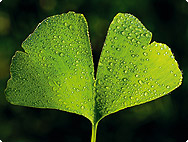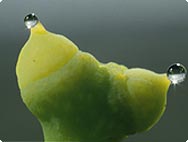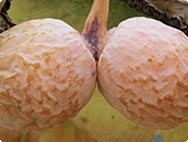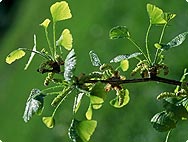A.Vogel search
When the internal search is activated, personal data such as your IP address is transmitted to our search engine Cludo. Data is thus transferred to a third country. Please click here if you want to display the internal search. You can find more information on data protection here: Privacy policy.
A.Vogel plant encyclopaedia
Ginkgo biloba L.
Ginkgo tree
History

The ginkgo tree is the only surviving representative of the ginkgo genus that flourished at around the time of the dinosaurs. For this reason it is also known as a "living fossil". 150 million years ago, the ginkgoinae were to be found all over Europe; they disappeared from Europe during the Ice Age. The only type of ginkgo to survive was ginkgo biloba, which survived in south eastern China, where it was cultivated and worshipped as the "tree of knowledge". In traditional Chinese medicine, ginkgo seeds were considered a highly valuable remedy for tuberculosis, on account of its strong antibiotic properties. Ginkgo was also administered as an expectorant, a sedative, digestant and vermifuge. The tree was taken from China and introduced to Korea and Japan where it was often planted in the vicinity of temples.
The ginkgo tree was described by the German doctor and naturalist Engelbert Kämpfer in 1712, who studied the tree during a two-year sojourn in Japan. The first ginkgo tree was planted in Europe between 1727 and 1737 at the botanical gardens in Utrecht. The ginkgo tree has been immensely popular in Europe ever since. The famous German poet, Wolfgang von Goethe described the plant's fascinating two-lobed leaves in a poem which appeared in his anthology West-Eastern Divan in 1815:
Ginkgo Biloba
This tree's leaf, which here the East
In my garden propagates,
On its secret sense we feast
Such as sages elevates.
Is it but one being single
Which as same itself divides?
Are there two which choose to mingle
So that one each other hides?
As the answer to such question
I have found a sense that's true:
It is not my songs' suggestion
That I'm one and also two?
Today, the ginkgo tree can be found all over the world and is prized just as much for its beauty as for its resistance to air pollution and insects. Unfortunately, the male trees are cultivated more often than the female, since the mature seeds of the female trees emit a rather unpleasant odour.
The ginkgo tree was given its botanical name ginkgo biloba by the botanist Carl von Linné in 1771. His choice was based on Engelbert Kämpfer's name for the tree. The Japanese name for the tree is ICHÔ (pronounced Ichoo) or ICHÔ NO KI (Ichô tree) and the valuable nuts are known as GINNAN. The character for both the tree as well as the nuts is written thus: .....The first sign, is pronounced GIN and means "silver". It is composed of the character for "gold, yellow, metal" and "good". The second character, comprises the characters for "tree" and "mouth" and is pronounced ANZU, meaning "apricot". Ginkgo nuts are uses in various traditional Japanese dishes. Roasted and lightly salted, they have a mild, slightly bitter aroma and make an excellent accompaniment to sake or beer.
Botanical characteristics

The ginkgo tree grows to a height of thirty or forty metres; it is dioecious and its trunk has a circumference of up to four metres. The ginkgo can achieve an age of up to four thousand years; although it will only flower for the first time after roughly twenty-five years, it remains fertile for over one thousand years. The bark is pale grey and roughly rutted. The leaves are presented either alternately on long annual shoots, or in bunches on shorter shoots. They have a characteristic fan-shape and are either lobed or unlobed, depending on the age of the tree. The venation of the ginkgo tree runs parallel, a reminder that it was once related to the conifer at a much earlier stage in its development. In the autumn the leaves turn a golden yellow colour and fall to the ground.
The female flowers comprise a short stem with two ovules. They are arranged individually in leaf axils or in groups on shootlets. The somewhat larger male blossoms are similar to catkins and are also arranged on shootlets. Fertilisation occurs as a result of motile sperm cells around five months after pollination. The mature seeds (often incorrectly described as fruits) develop into yellow balls of approximately 3 cm in diameter. The hard, fleshy outer skin gives off an unpleasant odour not unlike butyric acid. This skin is washed or rubbed off prior to use and the seeds are removed from the hard shell.
The plant flowers from April to May.
Habitat

There are large areas of naturally occurring ginkgo in China, Japan and Korea; it is also cultivated in plantations in Europe.
Preparation

A.Vogel/Bioforce produces a mother tincture from the fresh leaves of the ginkgo tree, shaken by hand to create a homeopathic dilution.
In order to make tea, dried leaves are usually used.